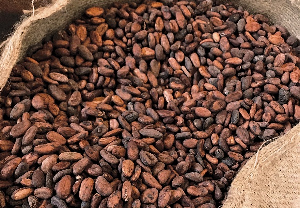 Cocoa is a key export commodity for Ghana
Cocoa is a key export commodity for Ghana
The local cocoa industry is bracing for significant shifts this year as market dynamics and regulatory pressures converge.
Analysts' projections at the beginning of the final quarter of 2024 suggested cocoa prices could rise to as high as US$9,600 per metric tonne (pmt) in 2025, due to tight global supply conditions. This figure was surpassed in December 2024, when prices reached US$11,925.
On January 8, 2025, March ICE NY cocoa futures closed at US$10,984.81 per metric tonne, reflecting a 1.68% decrease from the previous day. In December 2024, the global cocoa price reached US$10.32 per kilogram, marking a 30.73% increase from November 2024 and a 145.2% rise from December 2023.
The aforementioned constraints are exacerbated by adverse weather and illegal gold mining activities, which have reduced farmland availability.
This forecast follows a dramatic price surge in 2024 when cocoa prices nearly doubled by mid-November, reaching US$8,523 from an initial US$4,916—a 73.4% increase. The surge was driven by supply shortfalls in Ghana and Côte d’Ivoire, intensified by El Niño's impact on yields and growing global demand for chocolate.
According to Databank's 2025 projections, “The European Union Deforestation Regulation (EUDR), effective in early 2025, will further restrict supply availability, likely keeping prices elevated amid strong global demand for chocolate.”
Domestic Challenges
The domestic market has faced funding issues, with inefficiencies at the Ghana Cocoa Board (COCOBOD) cited as a major factor. In 2024, COCOBOD struggled to raise its annual syndicated loan from usual partners. These challenges, among others, have prevented local farmers from benefiting fully from the windfall brought by increasing prices.
In September 2024, COCOBOD announced a significant price increase for cocoa for the 2024–2025 season, pegging the price at GH¢48,000 per tonne. This translated to GH¢3,000 per 64-kilogram bag of cocoa, marking a 129.36% increase from the previous season.
Civil society, however, argued that the price—approximately US$185 at the time—fell short of what farmers deserved.
EU’s Deforestation Regulation to Reshape Industry
The impending EUDR introduces stringent requirements for cocoa producers, demanding that commodities entering the EU market be traceable and proven deforestation-free post-December 2020. While the regulation aims to curb environmental degradation, it poses substantial challenges for the local cocoa sector.
Traceability remains a critical hurdle. A Tropical Forest Alliance (TFA) paper on the EUDR indicated that in 2023, while 80% of cocoa exports from Ghana were linked to companies disclosing some supply chain information, only 9% of exports could be traced back to the district where they were produced.
Land ownership and tree tenure systems further complicate compliance. Under Ghana’s Concessions Act, naturally occurring trees on private land are vested in the state—disincentivizing farmers from preserving such trees.
According to Abraham Baffoe, Executive Director of Proforest, “The government has recently established a Tree Tenure and Benefit Sharing mechanism to ensure farmers and communities benefit from trees growing on their farms, but it will take time to be effectively implemented.”
Smallholder Farmers Bear the Compliance Burden
Smallholders, who account for nearly all cocoa production in the country, face the most significant challenges under the new regulation. Over 800,000 farmers depend on cocoa farming, with the industry employing 3.2 million people—17% of the working population. Many remain unaware of the EUDR requirements or the complexities of traceability.
“The message is simple: if you want to sell to Europe, you must stop cutting trees,” noted Mr. Baffoe. However, misconceptions persist, such as the belief that ‘sun cocoa’ is superior to ‘shade cocoa’ despite evidence from the International Cocoa Organisation that shaded environments are essential for optimal yields.
Efforts to educate farmers are gaining momentum. Organisations like Proforest, in collaboration with COCOBOD, are providing training on sustainable practices. Platforms such as the Africa Sustainable Commodities Initiative (ASCI) are engaging producers through workshops to facilitate compliance.
State Interventions and Funding Gaps
The government has initiated a National Cocoa Management System (NCMS), including a Cocoa Traceability System, to meet EUDR requirements. This system aims to map cocoa farms and ensure compliance with deforestation-free standards. However, implementation remains resource-intensive.
“To implement traceability on the ground, we need a digital ID for every farmer, tags for every bag of EUDR-compliant cocoa, and dedicated centres in all cocoa districts… and we need this all in one go, now!” Mr. Baffoe emphasized.
Financial constraints pose a significant barrier. While the European Forest Institute and philanthropic organisations like the Walmart Foundation have provided support, stakeholders are calling for broader financial assistance. “Proforest’s work with the Ghana government is being supported by the Walmart Foundation. They are offering fantastic support to smallholder farmers,” Mr. Baffoe added.
Stakeholders stress that compliance requires a collective approach. The Asunafo-Asutifi landscape initiative, part of the Ghana Cocoa Forest REDD+ Programme, exemplifies collaborative efforts to align agricultural production with forest conservation.
“If we had allowed things to go as designed by the EU, it would only result in companies working within their own supply chains—but that does not solve the issue,” Mr. Baffoe insisted, advocating for landscape-level initiatives to address deforestation across entire jurisdictions.